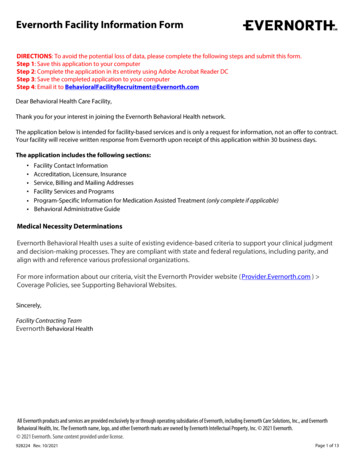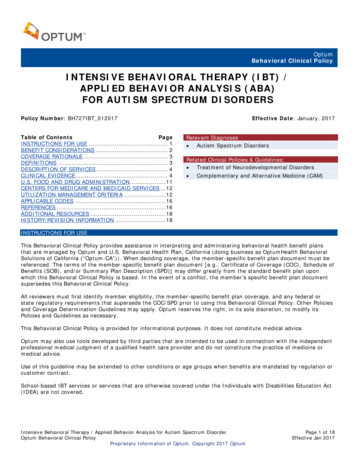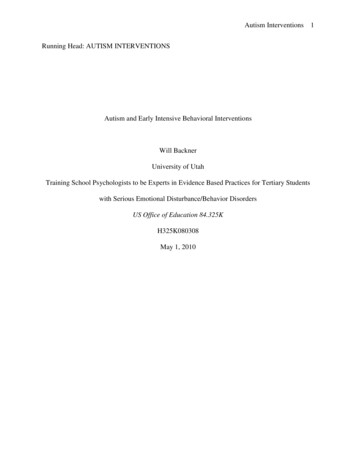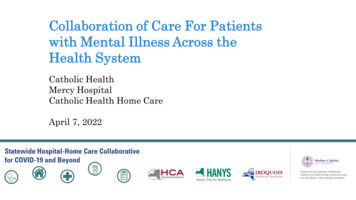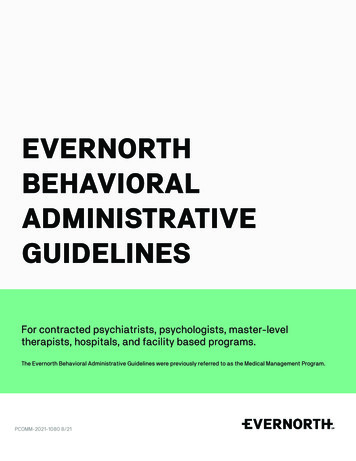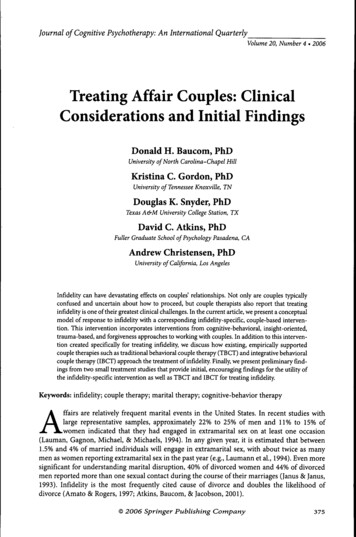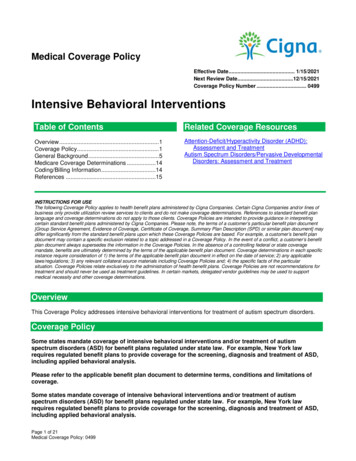
Transcription
Medical Coverage PolicyEffective Date . 1/15/2021Next Review Date.12/15/2021Coverage Policy Number . 0499Intensive Behavioral InterventionsTable of ContentsRelated Coverage ResourcesOverview . 1Coverage Policy.1General Background .5Medicare Coverage Determinations .14Coding/Billing Information .14References .15Attention-Deficit/Hyperactivity Disorder (ADHD):Assessment and TreatmentAutism Spectrum Disorders/Pervasive DevelopmentalDisorders: Assessment and TreatmentINSTRUCTIONS FOR USEThe following Coverage Policy applies to health benefit plans administered by Cigna Companies. Certain Cigna Companies and/or lines ofbusiness only provide utilization review services to clients and do not make coverage determinations. References to standard benefit planlanguage and coverage determinations do not apply to those clients. Coverage Policies are intended to provide guidance in interpretingcertain standard benefit plans administered by Cigna Companies. Please note, the terms of a customer’s particular benefit plan document[Group Service Agreement, Evidence of Coverage, Certificate of Coverage, Summary Plan Description (SPD) or similar plan document] maydiffer significantly from the standard benefit plans upon which these Coverage Policies are based. For example, a customer’s benefit plandocument may contain a specific exclusion related to a topic addressed in a Coverage Policy. In the event of a conflict, a customer’s benefitplan document always supersedes the information in the Coverage Policies. In the absence of a controlling federal or state coveragemandate, benefits are ultimately determined by the terms of the applicable benefit plan document. Coverage determinations in each specificinstance require consideration of 1) the terms of the applicable benefit plan document in effect on the date of service; 2) any applicablelaws/regulations; 3) any relevant collateral source materials including Coverage Policies and; 4) the specific facts of the particularsituation. Coverage Policies relate exclusively to the administration of health benefit plans. Coverage Policies are not recommendations fortreatment and should never be used as treatment guidelines. In certain markets, delegated vendor guidelines may be used to supportmedical necessity and other coverage determinations.OverviewThis Coverage Policy addresses intensive behavioral interventions for treatment of autism spectrum disorders.Coverage PolicySome states mandate coverage of intensive behavioral interventions and/or treatment of autismspectrum disorders (ASD) for benefit plans regulated under state law. For example, New York lawrequires regulated benefit plans to provide coverage for the screening, diagnosis and treatment of ASD,including applied behavioral analysis.Please refer to the applicable benefit plan document to determine terms, conditions and limitations ofcoverage.Some states mandate coverage of intensive behavioral interventions and/or treatment of autismspectrum disorders (ASD) for benefit plans regulated under state law. For example, New York lawrequires regulated benefit plans to provide coverage for the screening, diagnosis and treatment of ASD,including applied behavioral analysis.Page 1 of 21Medical Coverage Policy: 0499
Please refer to the applicable benefit plan document to determine terms, conditions and limitations ofcoverage.Medically NecessaryCriteria for Assessment for Applied Behavior Analysis (ABA)An assessment for applied behavior analysis (ABA) is considered medically necessary when ALL of thefollowing criteria are met: The individual has been diagnosed with Autism Spectrum Disorder (ASD) by a healthcare professionalwho is licensed to practice independently and whose licensure board considers diagnostics to be withintheir scope of practice. The name and credentials of the person who made the diagnosis and the date onwhich the diagnosis was made must be provided. The diagnosis must have been made based on thecriteria in the current edition of the Diagnostic and Statistical Manual of Mental Disorders (DSM). The assessment is being/will be performed by a Board Certified Behavior Analyst (BCBA) or a mentalhealth clinician who is licensed to practice independently and who has documented training in ABA. The assessment includes/will include the administration of a reliable and valid, standardized assessmentinstrument (e.g., Verbal Behavior Milestones Assessment and Placement Program [VB-MAPP], VinelandAdaptive Behavior Scale - 3, Assessment of Basic Language and Learning Skills – Revised [ABLLS-R],PDD Behavior Inventory [PDDBI], Social Responsiveness Scale, Second Edition [SRS-2], AdaptiveBehavior Assessment System – Third Edition [ABAS-3], Promoting the Emergence of AdvancedKnowledge [PEAK], Social Skills Improvement System [SSIS] Rating Scales) that has been completed inits entirety, as designed, and measures the domains included in the diagnostic criteria for AutismSpectrum Disorder as identified within the current edition of the DSM.Criteria for Initiation of Treatment with ABAABA is considered medically necessary when ALL the following criteria are met: The individual has been diagnosed with Autism Spectrum Disorder by a healthcare professionalwho is licensed to practice independently and whose licensure board considers diagnostics to bewithin their scope of practice and BOTH of the following: The name and credentials of the person who made the diagnosis and the date on which thediagnosis was made must be provided.The diagnosis must have been made based on the criteria in the current edition of the DSM.A full and comprehensive ABA assessment must have been completed that includes ALL of thefollowing: Assessment of current functioning in the areas impacted by Autism Spectrum Disordercompleted by a Board Certified Behavior Analyst (BCBA), or other independently licensedmental health clinician (with documented training in ABA) using reliable and valid,standardized assessment tools.Administration of a reliable and valid, standardized assessment instrument designed tomeasure the individual’s functioning in the following areas consistent with the diagnosticcriteria for Autism Spectrum Disorder in the current edition of the DSM: socialcommunication, social interaction, and restrictive, repetitive, and stereotyped patterns ofbehavior.The instrument must be completed in its entirety and as designed.Standardized score tables must be provided, when applicable.Page 2 of 21Medical Coverage Policy: 0499
Administration of the initial assessment instrument must have been completed within 60days of the request to initiate treatment.The results of the reliable and valid, standardized assessment instrument utilized indicatesdeficits in areas measuring the domains included in the diagnostic criteria for AutismSpectrum Disorder as defined by the most current edition of the DSM.A complete developmental history has been obtained including: relevant co-morbid conditionsvision and hearing evaluationscurrent medications Consideration of family/caregivers, including language or cultural factors that may impact treatment. An individualized treatment plan has been developed that includes ALL of the following: There is a clear plan to coordinate care with all other medical and mental health providers, and withgovernment mandated/school services including the following: Clearly defined and measurable goals designed to target specific behaviors/skills that havebeen identified for intervention based on the results of the assessment instrument(s) acrossall settings/environments where treatment will occur.Treatment goals are directly related to the symptoms of ASD as defined by the current editionof the DSM.Baseline data have been obtained and documented, with dates collected, for all behaviorsand skills identified for intervention across all settings/environments where treatment willoccur (e.g., home, clinic, school, and summer camp).Each goal includes mastery criteria consistent with the units of measurement identified withinthe goal indicating the standards for determining when a goal/objective has been/will be met.If group treatment is planned, the treatment plan must include clearly defined, measurablegoals for the group therapy that are specific to the individual and his/her targetedbehaviors/skills that have been identified for intervention based on the results of theassessment instrument(s).There is a clear plan to ensure maintenance and generalization of acquired skills across allsettings.There is a clearly defined, measurable, and realistic transition plan that includes a plan forfading services across all settings/environments where treatment will occur.There are clearly defined, measureable, and realistic discharge criteria that are individualizedto the individual.Applied Behavior Analytic services delivered by multiple providers during the sameauthorization period are considered medically necessary for the following situations:o Providers are addressing substantially different skillsoThere is a clear plan to coordinate care across providers, to ensure the services are notduplicative, and are consistent with clinical needs of the individual based ondocumentation and data collection.oProviders are using the same behavioral intervention strategies.The planned intensity of treatment reflects the severity of the impairments, goals of treatment, andresponse to treatment across all settings/environments where treatment will occur.Page 3 of 21Medical Coverage Policy: 0499
Supervision will be performed by a Board Certified Behavior Analyst (BCBA) or a mental healthprofessional who is licensed to practice independently and who has documented training in ABA andincludes ALL of the following: Parent/caregiver training will be conducted by a BCBA or a mental health professional who is licensed topractice independently and who has documented training in ABA and includes ALL of the following: The amount of supervision must be consistent with the generally accepted practice standard ofone to two hours per ten hours of direct treatment.Direct supervision (BCBA face-to-face with the individual and either the Registered BehaviorTechnician [RBT] or the Board Certified Assistant Behavior Analyst [BCaBA] delivering the directtreatment) time accounts for 50% or more of case supervision.Supervisory services requested/provided coincide with Current Procedural Terminology (CPT)code descriptions as identified by the AMA.There are clearly defined, measurable parent/caregiver (including teachers and otherstakeholders as appropriate) goals designed to teach them the basic behavioral principles ofABA and how to continue behavioral interventions in the home and community, as well asacross all settings/environments where treatment will occur.If group parent/caregiver training is planned, there are clearly defined, measurableparent/caregiver training goals for the group training that are individualized to theparent/caregiver.There is a clear plan to collect data to demonstrate the parents/caregivers (and appropriatestakeholders) are making progress toward meeting identified parent/caregiver (and appropriatestakeholder) training goals.Services must meet the definition of active treatment regardless of location (e.g., daycare, home, clinic,school, camp, recreational programs, community, job site, telemedicine) and includes ALL of thefollowing: Direct service provision consist entirely of active ABA treatment aimed at treating the symptomsof Autism Spectrum Disorder as defined by diagnostic criteria in the current edition of the DSMacross all settings/environments where treatment will occur.The therapist must remain within close enough proximity to the individual to allow for consistentpresentation of learning opportunities that relate to the goals and objectives identified within theplan of care/treatment plan (this does not apply to telehealth services, when applicable).For services that are focused primarily on addressing, preventing or responding to maladaptivebehavior(s), the identified behavior(s) must be occurring at a frequency that requires activeintervention throughout the time the therapist is with the individual.ABA services are not utilized to replace or replicate activities that are the responsibility of thesetting/environment where services occur (e.g., classroom aide, 1:1 teacher, tutor, vocationalassistant/coach).Criteria for Continued Treatment with ABAContinued treatment with ABA is considered medically necessary when: (1) the first bullet in the abovesection for initiation of treatment section was met at the time treatment was initiated; (2) ALL of criteriafrom initiation of treatment section above are currently met and (3) ALL of the following criteria are met: The plan of care has been updated to address the current identified skill deficits and maladaptivebehaviors, as well as progress made across all targeted areas.Page 4 of 21Medical Coverage Policy: 0499
Baseline, interim and current data have been obtained, with dates on which data were collected, for allbehaviors and skills identified for intervention across all settings/environments where treatment willoccur (e.g., home, school, summer camp).The data indicate that there has been ongoing and sustained progress toward mastering the treatmentgoals.There is evidence of measurable and ongoing improvement in targeted behaviors/skills as demonstratedwith the use of a reliable and valid, standardized assessment instrument completed at least once a yearand following any break in treatment.The individual’s parent(s)/caregiver(s) (including teachers and other stakeholders as appropriate)continue to actively participate in the treatment and the data indicate that they are making progresstoward mastering the parent/caregiver (and stakeholder) goals.Experimental, Investigational or UnprovenABA is considered experimental, investigational or unproven for all non-ASD indications.Intensive behavioral interventions other than ABA are considered experimental, investigational orunproven.Not Medically NecessaryServices that are considered primarily educational or vocational in nature, or related to academic orwork performance are considered not medically necessary.Provision of ABA treatment is considered not medically necessary when delivered to the sameindividual, at the same time as any other treatment modality (e.g., ABA and speech therapy, or ABA andoccupational therapy).General BackgroundIntensive behavioral interventions are comprehensive treatment programs that utilize a combination ofinterventions with the aim of improving cognitive and intellectual function, social and adaptive skill developmentand behavior problems. They have been proposed to treat autism spectrum disorders as well as other conditionsthat involve behavioral difficulties. The programs emphasize early intervention, individualization of treatment andan intensive approach. The programs may also be referred to as early intensive behavior intervention (EIBI),intensive behavior intervention (IBI) or early intensive behavioral treatment (EIBT). At times, the terms EIBI, IBI,EIBT are used interchangeably with applied behavior analysis (ABA), Lovaas therapy or Lovaas University ofCalifornia Los Angeles (UCLA) Program. The programs are intensive and range from 15 to 40 hours per week,delivered over a long period of time. The intensive behavior programs focus on identifying behaviors thatinterfere with normal developmental processes, understanding the relationship between a behavior and thechild’s environment and modifying those behaviors in such a way so as to improve the child’s functional capacity.Treatment goals focus on improving adaptive behavior, language/communication skills, decreasing problembehaviors, as well as improving cognitive/intellectual status and academic/developmental achievements.There is a formal credentialing process of professional behavior analysts through the Behavior AnalystCertification Board (BACB). The BACB credentials and recognizes practitioners at four levels: Board Certified Behavior Analyst–Doctoral Board Certified Behavior Analysts (BCBA) Board Certified Assistant Behavior Analysts (BCaBA) Registered Behavior Technician (RBT)Practitioners credentialed at the BCBA-D and BCBA levels are defined by the BACB as Behavior Analysts. TheBACB requires that BCaBAs, or Assistant Behavior Analysts, work under the supervision of a BCBA-D or BCBA.RBTs must work under the supervision of a BCBA-D, BCBA, or BCaBAPage 5 of 21Medical Coverage Policy: 0499
The BACB provides clinical guidelines regarding the delivery of ABA services as a treatment for ASD.The essential features of autism spectrum disorder are persistent impairment in reciprocal social communicationand social interaction and restricted, repetitive patterns of behavior, interests or activities. These symptoms arepresent from early childhood and limit or impair everyday functioning. Manifestations of the disorder vary greatlydepending on the severity of the autistic condition, developmental level, and chronological age, which leads tothe term spectrum. Autism spectrum disorder encompasses disorders previously referred to as early infantileautism, childhood autism, Kanner’s autism, high-functioning autism, atypical autism, pervasive developmentaldisorder not otherwise specified, childhood disintegrative disorder, and Asperger’s disorder (AmericanPsychiatric Association, 2013).There are no medical interventions that are effective in achieving a cure for autism; however, the condition maybe managed through a combination of behavioral, pharmacological and educational interventions.Diagnostic criteria for Autism Spectrum Disorder from:Diagnostic and Statistical Manual of Mental Disorders, Fifth Edition (DSM-5)A. Persistent deficits in social communication and social interaction across multiple contexts, asmanifested by the following, currently or by history (examples are illustrative, no exhaustive; see textof DSM-5)1. Deficits in social-emotional reciprocity, ranging, for example, from abnormal social approach andfailure of normal back-and-forth conversation; to reduced sharing of interests, emotions, oraffect; to failure to initiate or respond to social interactions.2. Deficits in nonverbal communicative behaviors used for social interaction, ranging for example,from poorly integrated verbal and nonverbal communication; to abnormalities in eye contact andbody language or deficits in understanding and use of gestures; to a lack of facial expressionsand nonverbal communication.3. Deficits in developing, maintaining, and understanding relationships, ranging for example, fromdifficulties adjusting behavior to suit various social contexts; to difficulties in sharing imaginativeplay or in making friends; to absence of interest in peers.Specify current severity:Severity is based on social communication impairments and restricted, repetitive patternsof behavior.B. Restricted, repetitive patterns of behavior, interests, or activities, as manifested by at least two of thefollowing, currently or by history (examples are illustrative, no exhaustive; see text of DSM-5):1. Stereotyped or repetitive motor movements, use of objects, or speech (e.g., simple motorstereotypies, lining up toys or flipping objects, echolalia, idiosyncratic phrases).2. Insistence on sameness,, inflexible adherence to routines, or ritualized patterns of verbal ornonverbal behavior (e.g., extreme distress at small changes, difficulties with transitions, rigidthinking patterns, greeting rituals, need to take same route or eat same food every day).3. Highly restricted, fixated interests that are abnormal in intensity or focus (e.g., strong attachmentto or preoccupation with unusual objects, excessively circumscribed or perseverative interests).4. Hyper- or hyporeactivity to sensory input or unusual interest in sensory aspects of theenvironment (e.g., apparent indifference to pain/temperature, adverse response to specificsounds or textures, excessive smelling, or touching of objects, visual fascination with lights ormovement).Specify current severity:Severity is based on social communication impairments and restricted, repetitive patternsof behavior.C. Symptoms must be present in the early developmental period (but may not be fully manifest until socialdemands exceed limited capacities, or may be masked by learned strategies in later life.D. Symptoms cause clinically significant impairment in social, occupational or other important areas ofcurrent functioning.E. These disorders are not better explained by intellectual disability (intellectual developmental disorder) orglobal developmental delay. Intellectual disability and autism spectrum disorder frequently co-occur; to makePage 6 of 21Medical Coverage Policy: 0499
comorbid diagnosis of autism spectrum disorder and intellectual disability, social communication should bebelow that expected for general developmental level.The DSM notes that individuals with a well-established DSM-IV diagnosis of autistic disorder, Asperger’sdisorder, or pervasive developmental disorder not otherwise specific should be given the diagnosis of autismspectrum disorder. Individuals who have marked deficits in social communication, but whose symptoms do nototherwise meet criteria for autism spectrum disorder, should be evaluated for social (pragmatic) communicationdisorder.Literature ReviewHayes Directory Report: Hayes (2014; 2020) conducted a review of the use of intensive behavioral intervention(IBI) for the treatment of autism spectrum disorder (ASD) compared with no treatment, low-intensity IBI, intensiveeclectic therapy, nonintensive school-based therapy, waitlist, home-based portage, or nonintensive appliedbehavior analysis (ABA)-based interventions. The review included 21 studies that evaluated IBI for ASD,including: one randomized controlled trial (RCT), eleven nonrandomized trials, two pretest/posttest studies, andfive prospective cohort studies, and two retrospective file review. The review included children diagnosed withASD and studies included 22-332 patients. The outcomes in the studies included: autism severity (13 studies),intelligence or cognitive skills (15 studies), visual-spatial/nonverbal skills (seven studies), language skills (ninestudies), adaptive behavior (20 studies), school placement (four studies). For IBI for ASD, the quality of theevidence was rated as low, mainly due to individual study limitations. The review concluded that an overall lowquality body of evidence mainly from poor-quality studies suggests that IBI improves intelligence or cognitiveskills, visual-spatial skills, language skills, and adaptive behavior compared with baseline levels or othertreatments. The evidence does not reflect any consensus as to whether the reported improvements are clinicallysignificant; very few studies reported on the clinical significance of findings. In addition the conclusion noted thatthere is a paucity of evidence regarding the durability of treatment following treatment cessation, as well asuncertainty regarding optimal therapy parameters, preclude firm conclusions regarding the efficacy of IBI forASD.The Agency for Healthcare Research and Quality (AHRQ) published a comparative effectiveness review of theeffects of available interventions on adolescents and young adults with ASD (ages 13 to 30) (Lounds, et al.,2012). The review focused on the following outcomes: core symptoms of ASD (impairments in social interaction,communication, and repetitive behavior); medical and mental health comorbidities; functional behaviors andindependence; the transition to adulthood; and family outcomes. The studies assessed interventions falling intothe broad categories of behavioral, educational, adaptive/life skills, vocational, medical, and allied healthapproaches. The comparators included no treatment, placebo, and comparative interventions or combinations ofinterventions. Intermediate outcomes included changes in core ASD symptoms and in common medical andmental health comorbidities as well as effects on functional behavior, the transition process, and familyoutcomes. Long-term outcomes included changes in adaptive/functional independence, academic andoccupational attainment or engagement, psychological well-being, and psychosocial adaptation. Harms werealso assessed.Across all categories of interventions, most studies (n 27) were of poor quality, and none was good quality. Fiverandomized controlled trials (RCT) were fair quality: four that investigated pharmacologic agents and one alliedhealth study that assessed a leisure/recreation program. Although positive results may be reported in individualstudies, the poor quality of the studies and the lack of replication of the intervention studies mean that thestrength of evidence for the body of evidence around any specific intervention is currently insufficient. Findingsfor the interventions included:Behavioral: Individual or group-based social skills training: Four poor-quality studies, with two reporting onmanualized (i.e., has a published treatment manual) intervention. Some gains in social skills on largelyparent-reported measures in short-term studies. Two studies lacked comparison groups; diagnosticapproach, participant characteristics, treatment fidelity not clearly reported. Computer-based social skills training: Three poor-quality, short-term studies. Some improvements inemotion recognition in treated participants; no differences in measures of generalization. SystematicPage 7 of 21Medical Coverage Policy: 0499
diagnostic approach not reported within studies; concomitant interventions and treatment fidelity notreported. Intensive behavioral treatment: One poor-quality case series with diverse participants. Some gains inadaptive behavior reported. Intervention not clearly described; treatment fidelity and concomitantinterventions not reported; assessors not masked.Adaptive/Life Skills: Specific life/transitional skills: Three, poor-quality, short-term studies assessing highly specific skills andunique interventions (e.g., shoe lacing, digital device use, rotating classroom schedule). Some gainsseen in individual studies but most lacked comparison groups. Systematic diagnostic approach notreported within studies; participants often not clearly characterized; differences in concomitantinterventions and treatment fidelity often not reported. Treatment and Education of Autistic and related Communication Handicapped Children (TEACCH)based model: One poor-quality cohort study; desirability of living situation and use of programming ratedmore highly for TEACCH than other conditions; group homes rated more desirable than institutions.Nonrandom assignment to groups; systematic diagnostic approach not reported within study;inclusion/exclusion criteria not clearly stated; interventions not fully described; assessors not masked.In 2014, the AHRQ published a systematic review that updated the behavioral intervention portion of thecomprehensive review of therapies for children with ASD that was published in 2011 (Weitlauf, et al., 2014).thereview included 65 studies comprising 48 randomized trials and 17 nonrandomized comparative studies (19good, 39 fair, and 7 poor quality) published since the prior review. The quality of studies improved compared withthe earlier review; however, the assessment of the strength of evidence (SOE), confidence in the stability ofeffects of interventions in the face of future research, remains low for many intervention/outcome pairs. Theauthors concluded that a growing evidence base suggests that behavioral interventions can be associated withpositive outcomes for children with ASD; however, despite improvements in the quality of the included literature,a need remains for studies of interventions across settings and continued improvements in methodologic rigor.Substantial scientific advances are needed to enhance understanding of which interventions are most effectivefor specific children with ASD and to isolate elements or components of interventions most associated witheffects.There have been several systematic reviews of intensive behavioral interventions for individuals with ASD(Reichow, et al., 2018; Roth,et al., 2014; Bishop-Fitzpatrick, et al, 2013; Strauss, et al., 2013; Reichow, et al.,2012; Warren, et al., 2011b; Peters-Scheffer, et al., 2011; Virués-Ortega, 2010; Makrygianni, et al., 2010;Spreckley, et al., 2009; Seida, et al., 2009; Eldevik, et al., 2009; Howlin, et al., 2009; Reichow and Wolery,2008). While the reviews do note that are some limitations in the literature that includes small sample size, lengthof follow-up, and reliance on data from non-randomized studies, that overall the reviews report positive benefitsof the treatment.There are several published studies regarding children with ASD (Mohammadzaheri, et al., 2014; Fernell, et al.,2011; Zachor, et al., 2011; Smith, et al., 2010; Remington, et al., 2007; Ben-Itzchak and Zachor, 2007; Magiati,et al., 2007; Eikeseth, et al., 2007; Sallows and Graupner, 2005; Howard, et al., 2005; Sheinkopf and Siegel,1998). Although many of the studies are limited by the small sample size and the length of time of treatment andfollow-up time there is a demonstrated improvement in outcomes for improvements in functional and socialadaptation, and cognitive skills including language and communication skills, intellectual function, or othermeasures for children with ASD.Other Intensive Intervention ProgramsIntensive intervention programs o
including applied behavioral analysis. Please refer to the applicable benefit plan document to determine terms, conditions and limitations of coverage. Some states mandate coverage of intensive behavioral interventions and/or treatment of autism spectrum disorders (ASD) for benefit plans regulated under state law. For example, New York law
